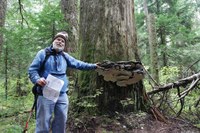
Red-Belted Conk, Fomitopsis (Fomes) pinicola
When the weather turns cold, wet, and even snowy, there is one group of fungi that can always still be found attached to branches and trunks in our Northwest woods. These are the Polypores—so named for the multitude of tiny pores that release spores from their generally smooth appearing under surfaces.
This particular perennial fruiting body, the Red-Belted Conk, appears shelf-like on the sides of old or dying trees, and where within the tree it forms a cubical brown rot on both the sapwood and heartwood. As such the Red-Belt Conk plays a major ecological role in creating soft wood cavities in snags and ultimately in the recycling of forest’s no longer living woody fiber back to nutrient rich soil.
While the top is dark brown-black in color, the species owes its common name to its outer edge which is often (but not always) distinctively marked with red to orange band--particularly in its late-early to “middle age” life.
The Red-Belted Conk while often up to a foot wide, can sometimes reach almost 3 times that size on the trunks of the largest old growth trees.
Starting out somewhat rounded or convex on the side of a tree, it soon becomes hoof shape before expanding as a larger, thick through, fan-like bracket.
Probably our most commonly encountered polypore species, the Red-Belted Conk, can be found growing on most western conifers, particularly on Douglas fir, but also on pines, true firs, western hemlock, western larch, spruce, western redcedar, and also on redwood. Throughout its North Hemisphere distribution it also attacks many hardwoods - infecting, in total, as many as 100 different host tree species. While this fungus’ shelves are usually found primarily growing on dead trees, stumps and logs, it will also occasionally attack living trees.
While like other polypores it is non-poisonous, this species especially is way too tough and woody in texture to ever be fried up with some butter and garlic in a skillet. However it is one of various shelf fungus species also known as “tinderwood fungus” that provided early explorers, settlers (and reportedly some Indian tribes) with a source of punk or tinder for helping to start campfires--where its inner texture remains dry and available above the ground when other potential fire starting materials are saturated from rain, or completely hidden below snow. In fact, the name Fomitopsis comes from the root (and former generic name) Fomes, meaning “tinder” and opsis, meaning resembling or similar to.
But, rather than busted up and burned, the dried conks of Fomitopsis pinicola can also be decoratively painted as your imagination may lead you.
PS: While I said you couldn’t eat it, there is definitely a body of knowledge out there which claims there is still another way this mushroom might save your life. Powdered Fomitopsis pinicola, marketed as a tea and food supplement is considered to be a medicinal mushroom that is said to be “widely consumed in Asia” where it is reported “to provide health, nutritional, and therapeutic benefits due to its antimicrobial, anti-inflammatory, and antitumor activities.”
 '
'
